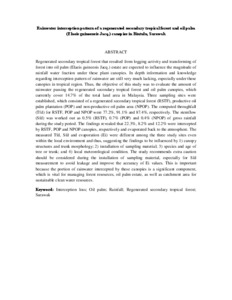Citation
Roslan, Mohd Salahuddin and James Gerusu, Geoffery and Mustafa Kamal, Abu Hena
(2018)
Rainwater interception pattern of a regenerated secondary tropical forest and oil palm (Elaeis guineensis Jacq.) canopies in Bintulu, Sarawak.
Borneo Journal of Resource Science and Technology, 8 (1).
pp. 41-55.
ISSN 2229-9769; ESSN: 0128-2972
Abstract
Regenerated secondary tropical forest that resulted from logging activity and transforming of forest into oil palm (Elaeis guineesis Jacq.) estate are expected to influence the magnitude of rainfall water fraction under these plant canopies. In depth information and knowledge regarding interception pattern of rainwater are still very much lacking, especially under these canopies in tropical region. Thus, the objective of this study was to evaluate the amount of rainwater passing the regenerated secondary tropical forest and oil palm canopies, which currently cover 14.7% of the total land area in Malaysia. Three sampling sites were established, which consisted of a regenerated secondary tropical forest (RSTF), productive oil palm plantation (POP) and non-productive oil palm area (NPOP). The computed throughfall (Tfd) for RSTF, POP and NPOP were 77.2%, 91.1% and 87.4%, respectively. The stemflow (Sfd) was worked out as 0.5% (RSTF), 0.7% (POP) and 0.4% (NPOP) of gross rainfall during the study period. The findings revealed that 22.3%, 8.2% and 12.2% were intercepted by RSTF, POP and NPOP canopies, respectively and evaporated back to the atmosphere. The measured Tfd, Sfd and evaporation (Ei) were different among the three study sites even within the local environment and thus, suggesting the findings to be influenced by 1) canopy structures and trunk morphology; 2) installation of sampling material; 3) species and age of tree or trunk; and 4) local meteorological condition. The study recommends extra caution should be considered during the installation of sampling material, especially for Sfd measurement to avoid leakage and improve the accuracy of Ei values. This is important because the portion of rainwater intercepted by these canopies is a significant component, which is vital for managing forest resources, oil palm estate, as well as catchment area for sustainable clean water resources.
Download File
![[img]](http://psasir.upm.edu.my/13709/1.hassmallThumbnailVersion/Rainwater%20interception%20pattern%20of%20a%20regenerated%20secondary%20tropical%20forest%20and%20oil%20palm%20%28Elaeis%20guineensis%20Jacq.%29%20canopies%20in%20Bintulu%2C%20Sarawak.pdf)  Preview |
|
Text (Abstract)
Rainwater interception pattern of a regenerated secondary tropical forest and oil palm (Elaeis guineensis Jacq.) canopies in Bintulu, Sarawak.pdf
Download (38kB)
| Preview
|
|
Additional Metadata
Actions (login required)
 |
View Item |

